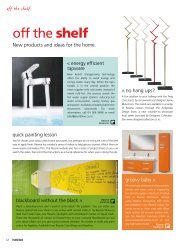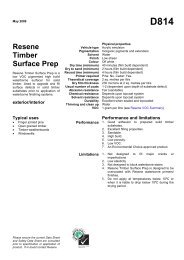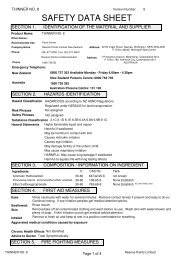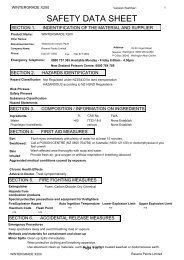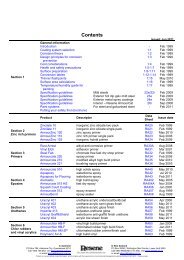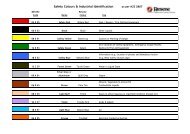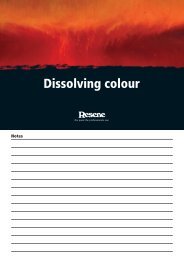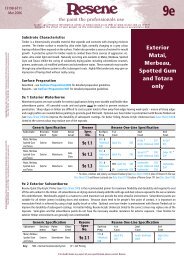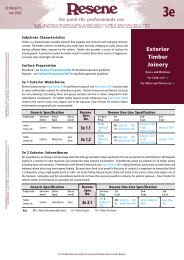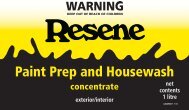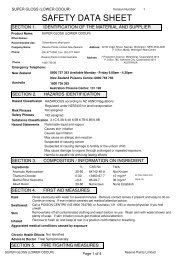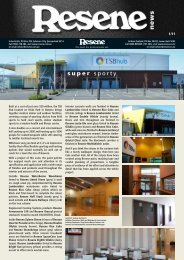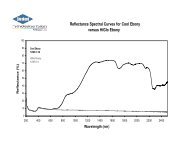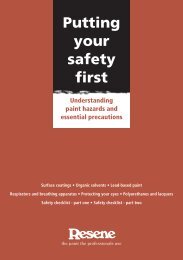Create successful ePaper yourself
Turn your PDF publications into a flip-book with our unique Google optimized e-Paper software.
<strong>Resene</strong> Professional development programmeThese <strong>rates</strong> <strong>for</strong> preparing surfaces are indicative, but always allow <strong>for</strong> at least moss and mould and paintcleaning plus water washing, it’s the least that is necessary!First, remove as much of the chalk residue as possible, scrubbing with a stiff bristle brush (or wire brushon masonry) and then rise thoroughly or use power washing equipment. Check <strong>for</strong> any remaining chalkby running a hand over the surface as it dries. If noticeable chalk is still present, apply a quality primer(or comparable sealer <strong>for</strong> masonry) then repaint with a quality exterior coating. If little or no chalkremains and the old paint is sound, no priming is necessary.Try to identify and eliminate the source of moisture. Prepare surface by removing all loose paint witha scraper or stiff wire brush. Sand rough edges and apply the appropriate primer. Repaint with a topquality waterborne exterior paint <strong>for</strong> best adhesion and water resistance.Old paint should be completely removed by scraping and sanding the surface. A heat gun may be usedto speed work on large surfaces, but take care to avoid igniting paint or substrate. The surface should beprimed with high quality primer, then painted with a high quality exterior waterborne paint.If blisters go down to the substrate try to remove the source of moisture. Repair loose caulking andconsider installing vents or exhaust fans. Remove blisters (see below).If blisters do not go all the way down the substrate then remove them by scraping, then sanding. Primebare wood and repaint with a quality exterior waterborne paint.Step 1 – Treat <strong>for</strong> moss and mouldMost exterior surfaces, except bare galvanised iron, willhave mould, and possibly moss, growing on them. It isnot enough to remove moss and mould without firstkilling it as any residual spores will simply grow backunderneath the new paint causing it to flake off.To treat, simply use a garden sprayer to apply <strong>Resene</strong>Moss & Mould Killer (D80). Wait a few hours <strong>for</strong> thesolution to take effect and thoroughly scrub off.Step 2 – WashingThe purpose of washing is to remove contaminants, suchas dirt, salt, mould residue (now it’s been killed), poorlyadhered paint and chalkiness, from old painted surfaces.The most effective way is to use <strong>Resene</strong> Paint Prep andHousewash (D812) or if you are <strong>painting</strong> a roof, <strong>Resene</strong>Roof and Metal Wash (D88).Simply wet the area with fresh water and wash using asoft bristled brush as you would a car. If you are preparingwindows use a scouring pad or a 3M stripper pad. A shortbristled scrubbing brush is ideal <strong>for</strong> unpainted concreteand plaster. Rinse clean with fresh water.Waterblasting is useful <strong>for</strong> hard surfaces, such asconcrete and galvanised iron, particularly when paintlayers need to be removed. However as a cleaner it is lesseffective than <strong>Resene</strong> Paint Prep and Housewash (D812)and when used on timber can damage it.Waterblasting is not recommended <strong>for</strong> joinery.An alternative is to use a wire brush or stripper pad toremove flaking paint from concrete particularly if onlysmall areas are flaking. A 3M stripper pad is ideal <strong>for</strong>removing flaking paint and mild rust from galvanisediron – avoid using a wire brush on galvanised iron asit will damage the surrounding protective zinc layer.Step 3 – Scraping and sanding timber andjoineryIf the old paint surface is sound and ‘deglossed´ thenit typically will not need to be sanded. An exceptionto this is where old enamels have not been exposed toU.V. light and are hard, embrittled with age and haveretained much of their original gloss – usually on theopening edges of window joinery and under eaves etc.Refer to the Sanding chart.Flaking paint will need to be scraped off. Once done,sand back to a sound surface ensuring the paint edgesare feathered.Note: 1: It is important to spot prime any bare timber thesame day as it is sanded and be<strong>for</strong>e any filling to preventovernight dew lifting the newly feathered paint edge.Note 2: It is good practice to rinse areas with clean waterbe<strong>for</strong>e <strong>painting</strong> commences each day to remove any saltdeposits – especially within 1.5km of the sea.Continued on page 3937



